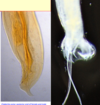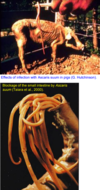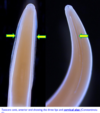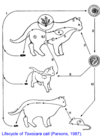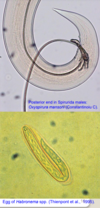Parasitology Flashcards
Describe the four layers on a nematode egg ?
- Uterine layer (not always present)
Common layers
- Vitelline layer
- Chitinous layer
- Lipid layer- resistance to desication and penetration of water soluble compounds.

Describe the morphology of the Order Rhabditida , Family Rhabditidae?

Rhabditida
- clear, transparent
- oesophagus contains a corpus and isthmus + bulb
- normally free living, becomes parasitic when animals are kept on wet dirty bedding
- infects skin, crusty, weeping lesions, loss of hair
- host dog, ox, sheep
- diagnose via scrapping of lesions.

Describe the morphology and characteristics of the Order Rhabditidae family Strongyloides species ?

Threadworm
- worldwide distribution
- free living adults
- adults usually reside in the small intestine duodenum, proximal jejunum, but occassionally in the respiratory tract
- oesophagus long 1/3 of body length
- L3 short lived no sheath, require warm moist environment for survival
- uterus intertwined with intesting
- only12-15 eggs in uteri at any one time
Only females are parasitic
Most distinguishing feature eggs thin shelled and embryonated.

Describe the lifecycle of Order Rhabditida Genus Strongyloides species ?

Complicated life cycle
- note only females are parasitic
- Direct or indirect life cycle
- Homogenic (Autoinfection)
- Heterogenic (environment and host infection)
- Homogonic
- Orally infected or subcutaneous infection
- autoinfection
Oral infection = L3 usually matures in the gut without any migration
Subcutaneous infected = migrate lungs, trachea, pharynx to small intestine to mature
- prepatent time 7-9 days
- may migrate to various tissues and organ especially mammary tissue and muscle. Here may be passed to offspring through milk/ colostrum.
- arrested development may occur
Type of life cycle will depend upon whether the host or environment is more favorable.

What is the prepatent period?
The time that elapses from when a host becomes infected to when the parasites develop into adults.
What is a direct and indirect lifecycle ?
Direct = monoxenous one host
Indirect lifecycle = heterogenous two or more host. Or part of their lifecycle is spent outside the host
What is a paratenic, mechanical and biological host?
Mechanical - no development or multiplication takes place
Biological - development or multiplication takes place
Paratenic - parasite does not undergo development, but remains alive and able to infect another host.
Describe the morphology of a nematode ?
- nema = Greek for thread like
- most cylindrical (round in cross section), elongated and tapered at both ends
- bilaterally symetrical
- pseudocoelom body cavity
- complete digestive system
- doecious, with the female usually being larger than the male
- teeth, cutting plates, leaf crowns or lips
Name four species of Strangloidae, Papillosus, Ransomi, Westeri, Stercoralis and their hosts ?
S. Papillosus = ruminant
S. Ransomi = pigs
S. Westeri = horses
S. Stercoralis = dog, cat and human
Location small intestine
S = Strongyloides or threadworms
Describe the morphological features of Strongylida ?

Order = haemonchus + cooperia etc
- bursate nematodes
- The bursa is bell shaped with three lobes.
- corona radiata (internal and external leaf crowns)
- 3-6 lips
- eggs thin shelled many cells (morula stage)
- usually have a direct life cycle

Describe the morphological features of Trichostrongylus ?

Trichostrongylus
- Tricho = very thin
- mouth small
- bursa well developed
- Locate = small intestine
- excretory pore half way
- most important parasite of ruminants
- generally mucosal browsers, feed on small particulate matter and mucus
Eggs = thin shelled with many cells inside.
Chemo resistance extremely problematic in this group.

Describe the life cycle of the order Strongylida?
- Direct life cycle
- females produce eggs which are passed in the faeces
- generally similar life cycle for all species, except the requirements for optimal temperature and humidity vary.
- development of larvae inside faecal mass
- larvae feed on bacteria and detritus
- location small intestine
L3 retains the cuticle of L2 which is exsheathed anterior to the site of infection.
- L3 more resistant but unable to feed
- Hypobiosis

What is Hypobiosis, and what factors will affect hypobiosis ?
Hypobiosis is when larvae undergo a period of arrested development in the early L3 or L4 stages.
Affected by
- Environmental conditions
- host immune response
- population size of adult worms (what happens with anthelminthic treatment)
- genetic factors
While larvae are in Hypobiosis they are
- nonpathogenic
- not affected by host immunity
- less susceptable to treatments.
Describe the morphology and characteristics of order Trichostrongloidea, genus Trichostrongylus ?

Trichstrongylus = hair worms, black worms and black scour worms
Most predominate parasite in cattle
Defining features
- Location abomasum
- causes villus atrophy
- small slender pale reddish brown worms
- no buccal cavity
- excretory pore in conspicuous ventral notch
- spicules are short brown stout and rigid
Eggs
- thin shell, many cells inside morula stage
- uneven poles
Describe the lifecycle of Trichostrongylus ?

Life cycle = that of Order Trichostrongloidea
but
- female deposits 100-200 eggs a day
- optimal temp 25
- arrested development at L3
- L3 retain cuticle of L2
- PPT 15-21 days

Describe the two species of Trichostrongylus T.Axei and T.Colubriformis ?
- T. Axei
- ruminants, horses and pigs
- Location abomasum stomach
- T. Colubriformis
- sheep and goats
- Location Duodenum
Describe the Morphology of Haemonchus ?

Haemonchus (Barbers pole)
- Order Strongylida
- Heavy infections = sudden death
- L4 feed on blood can cause fatal anemia
- locate abmomasum
- F barbers pole due to coiling of white uterus
- large bursa
- cervical papillae
- small tooth
- vulva flap
- eggs thin shelled lots of cells

Describe the host of the two Haemonchus species Contortus and Placei ?

Haemonchus Contortus = sheep + goats
Haemonchus Placei = cattle
Describe the life cycle of Order Strongylida, Genus Haemonchus ?

Barbers Pole worm
- Order Strongylida
- Very prolific females produce 5000-1000 eggs a day
- larvae low resistance to dehydration during development
- Development 10-15OC with 25-35OC being optimum
Infection occurs through the consumption of L3 from the pasture

Describe the morphology of the Order Strongylida, genus Ostertagia ?

Brown stomach worm
- location abomasum Teladorsagia = sheep
- male spicules relatively short divided distally into two or three processes
- Bursa two large lateral lobes and one small dorsal
- nodules
- has small cervical papillae
- small mouth

Provide the host for two species of Ostertagia Ostertagia and Teladorsagia ?
Ostertagia = cattle
Teladorsagia = sheep and goats
Describe the life cycle of Ostertagia ?

Ostertagia
- Location abomasum
- 100-200 eggs daily
- Larval development between 5 and 35OC, but optimal between 16-25 OC.
Species of Osteragia are well known for their tendancy to arrest as early as L4.
Ingested L3 enter glands in the abomasum where they elicit nodules.

What is type one and two Ostertagiosis ?
Ostertagiosis
Type one = ingestion of large quantities of larvae
Type two = synchronous maturation of large numbers of hypobiotic larvae from the mucosa.
Due to
- low intake of larvae
- mass removal of adult population
Describe the morphology and life cycle
of Order Strongylida Genus Cooperia ?

Cooperia
- Small red worms
- Location within the small intestine
- Small cephalic swelling transversally striated, remainder of body 14-16 longitudinal ridges
- large bursa
Eggs are thin shelled with many cells
Life cycle similar to other species of the Superfamily Trichostrongyloida.




























